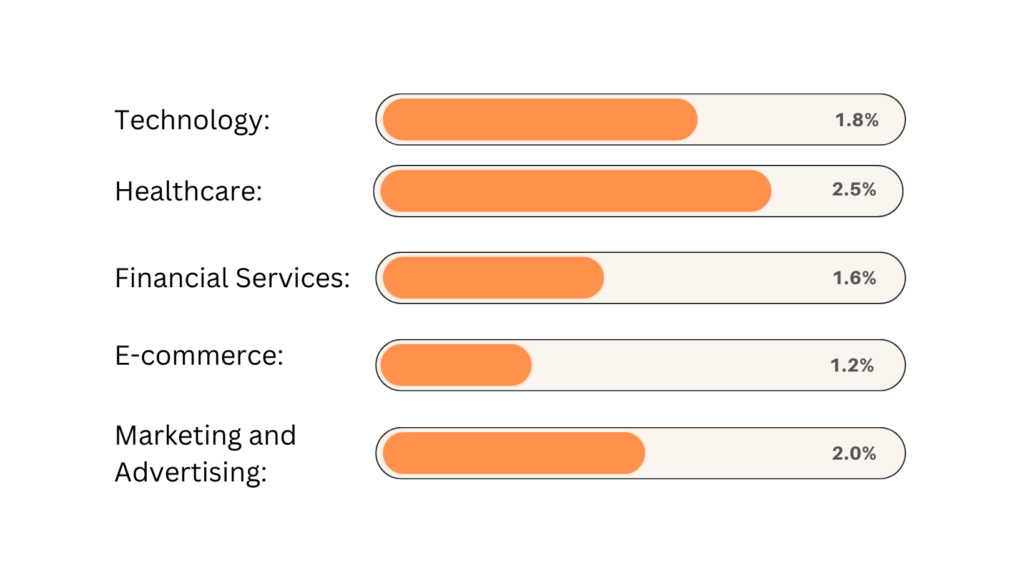When it comes to reaching out to potential clients or prospects, cold email remains one of the most effective methods.
But, what is the actual success rate of cold emails? Cold email success rate goes hand-in-hand with the response rate.
So if you are wondering, how can you measure your email campaign’s performance, and how do you improve the response rate to generate meaningful connections?
In this blog post, we’ll delve into the world of cold email success rates and share valuable tips on optimizing your outreach.
What Is the Average Cold Email Response Rate?
The average cold email success rate varies across industries and businesses, but it generally hovers around a modest 1% to 5% according to WriteCream.
While this might seem low at first glance, don’t let it discourage you. Cold emailing is a numbers game, and with the right strategies, you can significantly enhance your cold email success rate.
How To Calculate Cold Email Response Rate?
Calculating your cold email response rate is straightforward. Simply divide the number of positive responses (replies, meetings scheduled, or desired actions) by the total number of cold emails sent, then multiply the result by 100 to get the percentage.

For instance, say you sent out 100 cold emails, and you received 3 responses.
To calculate the response rate, divide the number of responses (3) by the total number of emails sent (100). Then, multiply the result by 100. In this case, your cold email response rate would be 3%.
Keep track of these metrics regularly to gauge the effectiveness of your campaigns and identify areas for improvement.
Benchmark for Cold Email Response Rates
Different industries have varying benchmarks for cold email reply rates due to factors like target audience, product/service type, and even the time of the year. As per the latest data, the average response rates for certain industries are as follows:

While these benchmarks provide a rough idea, remember that each campaign is unique, and your focus should be on outperforming your own previous efforts.
How Do You Improve Your Cold Email Response Rate?
1. Personalization is Key:
Address the recipient by name and demonstrate that you’ve done your research. Here are some tips to take your personalization to the next level.
Additionally, make sure to craft personalized subject lines that pique their interest.
2. Keep It Short and Sweet:
Time is a valuable resource, especially for busy professionals. Ensure your email gets to the point quickly and clearly communicates your value proposition. Use concise language without unnecessary fluff, making it easy for the recipient to grasp the main message at a glance.
One effective way to achieve brevity is by using bullet points or numbered lists to present key information in a scannable format. This allows the recipient to quickly understand the benefits you offer.
3. Focus on Value:
Your cold email should be centered around the recipient’s needs and pain points. Show how your product or service can solve their specific challenges or fulfill their desires. Emphasize the benefits they will gain from engaging with you rather than just listing features.
Avoid sounding overly salesy or pushy; instead, adopt a customer-centric approach that builds trust and credibility. Use testimonials or success stories to back up your claims and demonstrate your track record of delivering value.
4. A/B Testing:
A/B testing involves sending variations of your cold email to different segments of your target audience to see which version performs better. Experiment with different email formats, subject lines, calls-to-action, and even email templates to identify the most effective elements.
Through continuous testing and analysis of results, you can refine your approach and optimize your email for maximum impact.
5. Optimize Send Times:
Timing plays a crucial role in cold email success. Aim to send your emails during the middle of the week, typically on Tuesdays or Wednesdays. Mondays may not be ideal, as inboxes tend to be flooded with messages after the weekend, making it easy for your email to get lost.
Similarly, Fridays are not optimal since people often wind down for the weekend and may not engage as actively with their emails. Finding the right balance in send times can significantly impact your response rate.
6. Follow Up Strategically:
Sending a single cold email may not yield the desired results. Persistence is essential in cold emailing. Craft a well-thought-out follow-up email strategy and send a polite reminder after a few days or a week, depending on the urgency of your offer.
Following up reinforces your initial outreach, increases visibility, and shows genuine interest in engaging with the recipient. However, avoid becoming overly aggressive or spammy, as it may backfire and harm your reputation.
7. Clean Your Email List:
Regularly review and clean your email list to maintain a high deliverability rate. Remove bounced email addresses, inactive contacts, and any recipients who have explicitly unsubscribed. A clean and up-to-date list ensures that your cold emails reach the intended audience and enhance your sender’s reputation.
Conclusion
Cold emailing can be a powerful tool for expanding your network and driving business growth. While the average response rate might seem discouraging, with the right approach, you can surpass industry benchmarks and achieve meaningful results.
Follow the tips outlined in this post and boost your cold email succes rate.
Keep refining your strategies, analyzing results, and adapting to the preferences of your target audience.

Leave a Reply